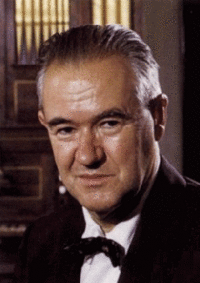E. Power Biggs facts for kids
Quick facts for kids
E. Power Biggs
|
|
|---|---|

From Biggs's CD,
Bach: The Four Great Toccatas and Fugues. |
|
| Born | March 29, 1906 Westcliff-on-Sea, England, UK
|
| Died | March 10, 1977 (aged 70) Cambridge, Massachusetts, U.S.
|
| Occupation | Organist, harpsichordist |
| Spouse(s) |
|
Edward George Power Biggs (March 29, 1906 – March 10, 1977) was a famous organist and recording artist. He was born in England but later moved to the United States. Biggs was known for helping to make the classical pipe organ popular again. He also encouraged musicians to play old music on instruments that were similar to those used when the music was first written.
About E. Power Biggs
Biggs was born in Westcliff-on-Sea, Essex, England. A year later, his family moved to the Isle of Wight. He trained in London at the Royal Academy of Music. There, he studied with a teacher named G. D. Cunningham.
Moving to America
Biggs moved to the United States in 1930. In 1932, he got a job at Christ Church in Cambridge, Massachusetts. He lived there for the rest of his life.
Bringing Back the Organ
Biggs did a lot to make the classical pipe organ important again. He was a leader in the mid-1900s. People started to become very interested in organ music from older composers. These composers lived before the Romantic music period.
Biggs's European Tour
In 1954, Biggs went on his first concert tour in Europe. He played and recorded music by famous composers like Johann Sebastian Bach, Sweelinck, Dieterich Buxtehude, and Pachelbel. He played on old organs that these composers might have used.
Playing Music Historically
After his tour, Biggs believed that old music should be played on instruments from that time. He also thought musicians should use the same styles and sounds (called "registrations") that were popular back then. This idea helped bring back a certain style of organ building in America. These new organs were like the old European Baroque instruments. This led to more people using tracker organs, which are a type of organ with a special mechanical system.
Favorite Organs and Instruments
Biggs loved certain instruments. One was a Baroque-style organ built by G. Donald Harrison. This organ was special because it was "unenclosed," meaning its pipes were open and not hidden. It had 24 stops (which control the sounds) and was installed at Harvard's Busch-Reisinger Museum in 1937.
The Flentrop Organ
Another important instrument for Biggs was the three-manual Flentrop tracker organ. This organ was put in the same museum in 1958. Many of his radio shows for CBS and recordings for Columbia were made there.
The Pedal Harpsichord
Biggs also used a special instrument called a pedal harpsichord. This was a harpsichord that you could play with your feet, like an organ. He recorded music by J. S. Bach and Vivaldi on it. He even played music by Scott Joplin and Tchaikovsky on this unique instrument!
Biggs and Other Musicians
Some people, like fellow organist Virgil Fox, had different ideas from Biggs. Fox was known for a more showy and colorful way of playing. He thought Biggs's focus on historical accuracy made the organ seem like an old museum piece.
Different Styles, Big Success
Even though they had different styles, both Biggs and Fox were very successful. Many people agree that Biggs should be praised for his new ideas about the music he recorded. He also made the organs he played even more famous. Besides concerts and recordings, Biggs also taught at the Longy School of Music in Cambridge, Massachusetts. He also helped edit a lot of organ music.
Awards and Recognition
Biggs was chosen as a fellow of the American Academy of Arts and Sciences in 1950. For his amazing work in the recording industry, Biggs has a star on California's Hollywood Walk of Fame. You can find it at 6522 Hollywood Boulevard. He was also honored in December 1967 when the New York Philharmonic celebrated its 125th birthday.
Selected Recordings
Biggs made many recordings for Columbia Masterworks Records and RCA Victor for over 30 years. From 1942 to 1958, he also had a weekly radio show about organ music on the CBS Radio Network. This show helped many people learn about the pipe organ and its music.
Here are some of his well-known recordings:
- Works for Organ: Essential Classics (1961)
- Bach: Organ Favorites (1961)
- The Golden Age of the Organ (1962)
- Heroic Music for Organ, Brass and Percussion
- Mozart: The Music for Solo Organ—Played on the "Mozart" organ at Haarlem (1966)
- E. Power Biggs' Greatest Hits (1969)
- Plays Bach in the Thomaskirche (1971)
- Bach: Four Great Toccatas & Fugues (Cathedral of Freiburg) (1974)
- Stars and Stripes Forever: Two Centuries of Heroic Music in America (1976)
- Historic Organs of England
- Historic Organs of France
- Historic Organs of Italy
- Historic Organs of Spain
- Historic Organs of Switzerland
- Bach on the Pedal Harpsichord
- Holiday for Harpsichord
- The Organ in Sight and Sound (This recording explained the organ and its history!)
- Plays Scott Joplin on the Pedal Harpsichord
- What Child Is This? Traditional Christmas Music
- Bach: Toccata in D Minor (recorded on 14 different organs in Europe!)
Awards and Recognition
Biggs won a special award for his music:
- Grammy Award for Best Chamber Music Performance:
- Vittorio Negri (conductor), E. Power Biggs & the Edward Tarr Ensemble, for Glory of Gabrieli Vol. II: Canzonas for Brass, Winds, Strings and Organ (1969)

